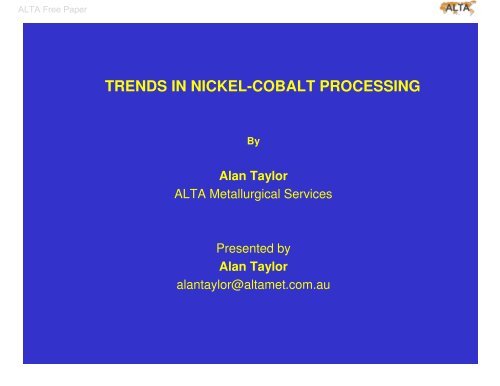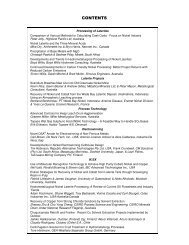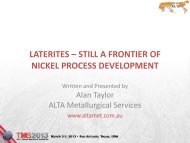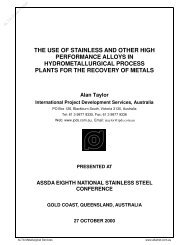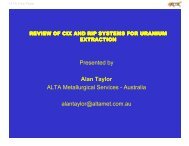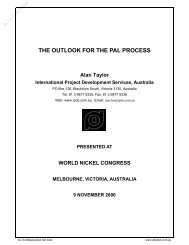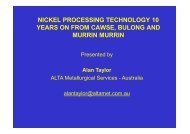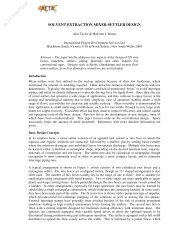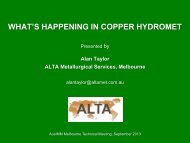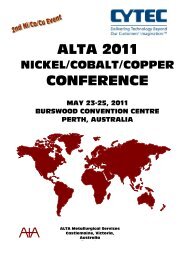trends in nickel-cobalt processing - ALTA Metallurgical Services
trends in nickel-cobalt processing - ALTA Metallurgical Services
trends in nickel-cobalt processing - ALTA Metallurgical Services
Create successful ePaper yourself
Turn your PDF publications into a flip-book with our unique Google optimized e-Paper software.
<strong>ALTA</strong> Free PaperTRENDS IN NICKEL-COBALT PROCESSINGByAlan Taylor<strong>ALTA</strong> <strong>Metallurgical</strong> <strong>Services</strong>Presented byAlan Tayloralantaylor@altamet.com.au
<strong>ALTA</strong> Free PaperINDUSTRY TRENDS - LATERITES - PAL• Two PAL plants closed – Cawse and Ravensthorpe(BHPB review<strong>in</strong>g future of Yabulu operation which wasto receive MHP from Ravensthorpe).• Vale Inco’s Goro operation <strong>in</strong> New Caledonia due onstream by the end of the 2009.• Expansion of Sumitomo’s Coral Bay (Rio Tuba).operation <strong>in</strong> Philipp<strong>in</strong>es due on l<strong>in</strong>e 2009.• Sherritt’s Ambotovy Project construction slowed, dueto be completed by end of 2010.• MCC/Highlands Pacific Ramu Project <strong>in</strong> PNG due onstream at end of 2009.• Expansion project for Moa Bay slowed.• Vale Brazil’s Vermelho Project on hold.• Gladstone Project <strong>in</strong> QLD has received approval forEIS and are seek<strong>in</strong>g f<strong>in</strong>anc<strong>in</strong>g to proceed.3
<strong>ALTA</strong> Free PaperINDUSTRY TRENDS – LATERITES - SMELTING• Vale Onça Puma ferro<strong>nickel</strong> project, Brazil, slowed byat least one year, now due on stream <strong>in</strong> January 2010.• Koniambo ferro<strong>nickel</strong> project SMSP/Xstrata due on l<strong>in</strong>e2011.• Large reduction <strong>in</strong> <strong>nickel</strong> pig iron production <strong>in</strong> Ch<strong>in</strong>adue to lower metal price.5
<strong>ALTA</strong> Free PaperINDUSTRY TRENDS – SULPHIDES - HYDROMET• Construction of Voisey’s Bay pressure oxidationoperation due to start <strong>in</strong> 2009 and be complete 2013.• Tati Nickel Activox Project <strong>in</strong> Botswana suspended byNorilsk.• Talvivaara heap bioleach<strong>in</strong>g operation <strong>in</strong> F<strong>in</strong>land nowon stream.• PolyMet M<strong>in</strong><strong>in</strong>g is <strong>in</strong> the late stages of theenvironmental review process for their NorthMet Project<strong>in</strong> M<strong>in</strong>nesota USA us<strong>in</strong>g the PLATSOL pressureoxidation process.6
<strong>ALTA</strong> Free PaperWHAT ARE THE OVERALL EFFECTS?• Fundamentals are largely unchanged.• Nickel demand is likely to <strong>in</strong>crease aga<strong>in</strong> due toconsumption by Ch<strong>in</strong>a, India and other develop<strong>in</strong>gcountries.• Most of future new <strong>nickel</strong> will have to come fromlaterites.• Environmental issues will cont<strong>in</strong>ue to promotehydromet for new sulphide projects.7
<strong>ALTA</strong> Free PaperLATERITE PROCESSING DEVELOPMENTS• Most new projects will have to process ore too lowgrade and with unsuitable m<strong>in</strong>eralogy for smelt<strong>in</strong>g.• Thus they will have to use some form of leach<strong>in</strong>gprocess.• Commercially applied processes are:- PAL- PAL with an associated AL circuit- Heap leach<strong>in</strong>g- Reduction roast-ammonia leach (Caron) process8
<strong>ALTA</strong> Free PaperPAL:LATERITE PROCESSING DEVELOPMENTS (CONT.)• Currently selected for all large laterite leach<strong>in</strong>g projects.• Experience now ga<strong>in</strong>ed from a number of commercialoperations.• The least sensitive to m<strong>in</strong>eralogy.• Sensitive to sulphuric acid price.• Relatively <strong>in</strong>sensitive to climatic conditions9
<strong>ALTA</strong> Free PaperLATERITE PROCESSING DEVELOPMENTS (CONT.)PAL with associated AL:Compared with PAL only –• Extends operation to economically process higheracid consum<strong>in</strong>g portions of deposit.• Reduces consumption of neutraliz<strong>in</strong>g agent.• Reduces overall capex per unit of <strong>nickel</strong> production.• Reduces PAL equipment requirements.10
<strong>ALTA</strong> Free PaperLATERITE PROCESSING DEVELOPMENTS (CONT.)Heap leach<strong>in</strong>g:• Lower capex.• Potentially more suitable than PAL for small andmedium size projects.• Can be applied as a satellite to a PAL operation totreat suitable portions of the deposit.• Generally has higher acid consumption than PAL,which <strong>in</strong>creases opex and exposure to acid price.• Lower metal extractions and slow leach k<strong>in</strong>etics.• Relatively sensitive to m<strong>in</strong>eralogy.• More sensitive to climatic conditions than PAL.• Limited commercial experience to date.11
<strong>ALTA</strong> Free PaperLATERITE PROCESSING DEVELOPMENTS (CONT.)Reduction roast-ammonia leach:• Proven technology.• Mild operat<strong>in</strong>g conditions: reduction < 800C, highpH solution leach not aggressive.• High energy required for ore dry<strong>in</strong>g.• Nickel recovery only moderately high.• Cobalt recovery relatively low.• Sensitive to ore m<strong>in</strong>eralogy.• No recent new plants.12
<strong>ALTA</strong> Free PaperOPPORTUNITY FOR NEW LATERITE PROCESSESIdeal specifications::• High recoveries of <strong>nickel</strong> and <strong>cobalt</strong>.• Lower capex and opex than exist<strong>in</strong>g processes• No <strong>in</strong>itial energy <strong>in</strong>tensive dry<strong>in</strong>g step.• Atmospheric pressure operation.• Low net reagent consumption.• Ability to provide separate <strong>nickel</strong> and <strong>cobalt</strong> products.• Suitable for large and small projects.• Low to moderate corrosivity.• Low environmental impact.13
<strong>ALTA</strong> Free PaperPROCESSES UNDER DEVELOPMENT• Atmospheric sulphuric acid leach<strong>in</strong>g (AL)• Sulphation atmospheric leach (SAL Process)• Atmospheric chloride leach<strong>in</strong>g14
<strong>ALTA</strong> Free Paper• Low capex than PAL.AL - POTENTIAL ADVANTAGES• Less aggressive leach conditions than PAL.• Lower ma<strong>in</strong>tenance cost than PAL.• Atmospheric pressure operation.• Simpler operation than PAL.• Higher on-stream availability – <strong>in</strong>dividual leach tanks canbe by-passed.15
<strong>ALTA</strong> Free PaperAL - CHALLENGES• High acid consumption.• Longer retention times than PAL.• Need to process leach solutions with high impurities,especially iron.• Lower recoveries than PAL.• Aggressive conditions – though less so than PAL.16
<strong>ALTA</strong> Free PaperAL - STATUS• No stand alone commercial operations as yet.• Operated at Ravensthorpe for treat<strong>in</strong>g saprolite ore <strong>in</strong>parallel with PAL for limonite (EPAL Process). Benefitsfrom availability of “free” acid from PAL discharge.• A number of projects us<strong>in</strong>g sulphuric acid are at variousstages of development.17
<strong>ALTA</strong> Free PaperSAL PROCESS• Skye Resources, Canada, have piloted a sulphationatmospheric leach process (SAL Process) at SGSLakefield as a possible option for the Fenix Project <strong>in</strong>Guatemala.• Features <strong>in</strong>itial sulphation of limonite ore by pugg<strong>in</strong>g withstrong sulphuric acid, which generates 140C temperature- thus accelerat<strong>in</strong>g leach k<strong>in</strong>etics. Iron forms ferricsulphate.• Second stage consists of add<strong>in</strong>g crushed saprolite oreand water and gr<strong>in</strong>d<strong>in</strong>g <strong>in</strong> ball mill, then leach<strong>in</strong>g forabout 24 hrs <strong>in</strong> series of agitated tanks with temp.ma<strong>in</strong>ta<strong>in</strong>ed at 95-105C.• Limestone is added and iron is hydrolyzed to ferrichydroxide. Acid is generated which leaches saprolite.SO2 is added to reduce <strong>cobalt</strong> and enhance extraction.18
<strong>ALTA</strong> Free PaperSAL PROCESS (SGS PRESENTATION AT <strong>ALTA</strong> 2007)ROMLimoniteCrushedSaproliteLeach SlurryPreparation (LSP):H 2 SO 4H 2 OLimonite SulphationSaprolite Gr<strong>in</strong>d<strong>in</strong>gSO 2CaCO 3WashUpstream Circuit:Atmospheric Leach<strong>in</strong>g (AL)Primary Iron Removal (PIR)Counter Current Decantation (CCD)Leach ResidueCaCO 3MgOCa(OH) 2Ca(OH) 2Downstream Circuit:Secondary Iron Removal (SIR)Mixed Hydroxide Precipitation (MHP)Scavenger Precipitation (SP)Manganese Removal (MR)SIR/SP SolidsrecycleMHP SolidsMR SolidsMgSO 4 liquor19
<strong>ALTA</strong> Free PaperSAL PROCESS (CONT.)• Pilot plant achieved <strong>nickel</strong> and <strong>cobalt</strong> leach extractions of85-89%.• Acid consumption 600 kg/t (for 9-10% Mg content)• Downstream process was conventional MHP circuit.20
<strong>ALTA</strong> Free PaperATMOSPHERIC CHLORIDE LEACH• Chloride leach<strong>in</strong>g tested for the Young Laterite Project forJervois M<strong>in</strong><strong>in</strong>g, NSW, Australia, us<strong>in</strong>g magnesiumchloride-HCl lixiviant.• Iron is precipitated as hematite and lixiviant regenerated.• Tests <strong>in</strong>dicate high pulp filtration rate allow<strong>in</strong>g use of beltfilters, which is much more favourable than sulphuric acidleach residue solid-liquid separation• Chloride leach<strong>in</strong>g has also been tested by Chesbar/Jaguar Nickel <strong>in</strong> Canada and Intec <strong>in</strong> Australia.21
<strong>ALTA</strong> Free PaperCHLORIDELEACHFLOWSHEETTESTED FORYOUNG PROJECT(BRYN HARRISPRESENTATIONAT <strong>ALTA</strong> 2006)22
<strong>ALTA</strong> Free PaperPREVIOUSLY PROPOSED LATERITE PROCESSESNumerous processes proposed over years <strong>in</strong>volv<strong>in</strong>gpyrometallurgy, hydrometallurgy, vapour metallurgyand comb<strong>in</strong>ations <strong>in</strong>clud<strong>in</strong>g:• Segregation roast<strong>in</strong>g• Sulphation roast<strong>in</strong>g• Republic Steel HSO - HTCP Process• Aqueous chlor<strong>in</strong>ation23
<strong>ALTA</strong> Free PaperPREVIOUSLY PROPOSED LATERITE PROCESSES (CONT.)• Nitric acid leach<strong>in</strong>g• Carbonyl extraction (Inco)• Sulphur dioxide leach<strong>in</strong>g• Reduction roast - sulphuric acid leach<strong>in</strong>g• Gas phase sulphation with SO2/air - water leach• Submerged lance smelt<strong>in</strong>g (Ausmelt)24
<strong>ALTA</strong> Free PaperFIELD STILL WIDE OPENNo one has come up with areal w<strong>in</strong>ner to date.So opportunity still KNOCKS25
<strong>ALTA</strong> Free PaperFURTHER DEVELOPMENTS OF PALIn the meantime possible further developments ofPAL <strong>in</strong>clude:• Flotation for upgrad<strong>in</strong>g some saprolitic ores.• Treatment of blended laterite/sulphide feed forgenerat<strong>in</strong>g acid and heat <strong>in</strong> autoclaves.• Extraction and reuse of residual leach acid bySX/IX/membranes.• Development of more selective SX extractants,<strong>in</strong>clud<strong>in</strong>g synergistic mixtures.• Application of RIP to reduce the number of CCDthickeners (or elim<strong>in</strong>ate totally) and reduce solublemetal losses.26
<strong>ALTA</strong> Free PaperSULPHIDE PROCESSING DEVELOPMENTSPresent trend <strong>in</strong> hydromet process<strong>in</strong>g appears to be:• Pressure oxidation for concentrates.• Heap bio-oxidation for low grade ores.Other possibilities <strong>in</strong>clude:• Tank bioleach<strong>in</strong>g.• Chloride leach<strong>in</strong>g.27
<strong>ALTA</strong> Free PaperVOISEY’S BAY PRESSURE OXIDATION FLOWSHEET(FROM PUBLISHED PROJECT EIS)28
<strong>ALTA</strong> Free PaperTALVIVAARA HEAP BIOLEACHING FLOWSHEET((PAPER AT <strong>ALTA</strong> 2007)29
<strong>ALTA</strong> Free PaperFURTHER DEVELOPMENTS FOR SULPHIDE FLOWSHEETSAdditional developments could <strong>in</strong>clude:• Treatment of blended laterite/sulphide feed forgenerat<strong>in</strong>g acid and heat <strong>in</strong> autoclaves.• Application of more selective SX extractants,<strong>in</strong>clud<strong>in</strong>g synergistic mixtures.30


